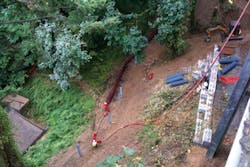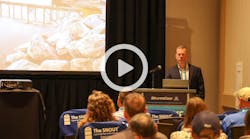Timing hydroseeding correctly requires balance and planning. Depending on the time of year, contractors like Brian Young, general manager of Fox Erosion Control & Landscape Inc. based in Clackamas, OR, are either fast approaching or past the seeding windows as set for his region by the Oregon Department of Transportation: September 1 through October 31. For many erosion control companies, planning site protection depends on the seasons, with combinations of erosion control methods spun out in scenarios that keep soil in place and public concerns at bay.
Highways: A View From the Shoulder
When erosion from highway construction poses a risk to residential areas, sediment control can find itself in the public spotlight. Begun in October 2010 and completed in December 2014, the I-5 Southwest Iowa Street Viaduct project located on approximately 6 acres in Portland, OR, included the replacement of “a large section of I-5 situated approximately 150 feet above a ravine that fed into an affluent neighborhood in the Portland area,” describes Young. Located south of downtown Portland, the project maintained a high level of visibility throughout.
“A lot of state officials drove by that job every single day. There was a lot of public awareness prior to and during construction. They had public liaisons full-time basically heading off [any issues]. Importantly, they were keeping the public apprised,” says Young, adding that many residences could have been affected if erosion control measures failed. “You’ve got to picture this massive hillside that could end up in somebody’s backyard. There were a lot of people that had their eyes on this project. The project was very sensitive to sediment-laden runoff and soil erosion due to excavation associated with bridge and wall construction taking place directly above the neighborhood.”
Fox Erosion Control worked as a subcontractor on the project. The project owner was the Oregon Department of Transportation.
“Our portion of the erosion control work started out as a straw mulching; we were pneumatically applying straw on exposed soils,” says Young. “With this project being located on I-5 with non-stop, fast-moving traffic and the deep ravine below the new stretch of freeway, it created a Venturi effect, and the straw was being blown away.”
Soon, the state recognized this tactic wouldn’t be a successful measure.
“This was not something they were going to attack on a wet-weather or monthly basis. This was a weekly visit for us. Every single Friday, after earthwork ceased, we’d be called in to apply heavy applications of flexible growth medium to all exposed excavations,” says Young. “From an operational standpoint, we had a lot of precarious spots we had to get into, a lot of very steep, exposed cut and fill slopes, and a lot of traffic. Our equipment operators were located on the top deck of the hydroseeding equipment shooting all cut and fill slopes from the shoulder of Interstate 5.
“Of course, all traffic control devices were in place. However, it definitely gets the blood pumping when cars are zipping by at 70 miles per hour, and more than likely watching our large seeding equipment shooting ‘the green stuff’ 150 feet up a cut slope!”
Approximately $180,000 of the project’s budget was associated with change order work for controlling runoff and slope stabilization, according to Young.
There were two basic seed mixes employed at the site. Young says the roadside mix included Achillea millefolium, Anaphalis margaritacea, and Bromus carinatus, and the second mix included Elymus glaucus, Lupinus polyphyllus, Solidago canadensis, Triticum elytrigia. Fox Erosion Control also used a mycorrhizal inoculant called Eco-Live that was added to the seed mixture. All of these had to be on a qualified products list and approved for use by the state.
The company used a large Finn Corp. Finn T-330 for hydroseeding and a Finn BB-1222 bark blower for installation of compost erosion blankets, socks, and berms. The flexible growth medium was Flexterra from Profile Products.
“The hydraulically applied material was specified at a very high application rate,” says Young. “With the viscosity, it was imperative to have the agitation devices and pumping capabilities of the Finn equipment. In my opinion, the performance of the Finn equipment is like none other in the industry.”
Accessibility was also an issue for a CalTrans October 2014 road blowout repair and revegetation project on State Route 74 in Hemet, CA.
Ramon Godinez, an erosion control and geosynthetics specialist at Ewing Irrigation based in Riverside, CA, says the site was not accessible using big equipment. In addition, he notes, the site’s soil condition “was a big challenge: poor nutrient value in the soil in combination with very erosive, sand-dominant soils.”
To stabilize the site, the company selected a product from Organic Earth Industries. “It’s an innovative product that combines a hydraulic growth medium and mulch in one bag,” he says.
With a very small window to apply the material because of a rainstorm predicted within a few days, says Godinez, a combination of hydroseeding techniques were employed.
“We used fiber rolls to control run-on from the road above and also in the middle of the slope to hold back any initial erosion from sandy soils. We used a slurry mix of Organic Earth Industries’ Omega HGM2, Quantum Growth’s Quantum-VSC and Quantum-Light bacteria, and an organic 4-4-4 fertilizer to give this project the best chance for vegetation sustainability.”
This decision ultimately made a positive impact on the overall cost for erosion control for the site.
“The estimated cost for this project was approximately $12,000, which was a bargain to the state because the other option would have been to lug in and spread compost or topsoil on steep hillside, then apply a BFM [bonded fiber matrix] type of hydromulch to control erosion,” says Godinez. “The revegetation goal was to get something—anything—to grow on this slope, because the state had never been successful in establishing much vegetation on this particular area of highway.”


